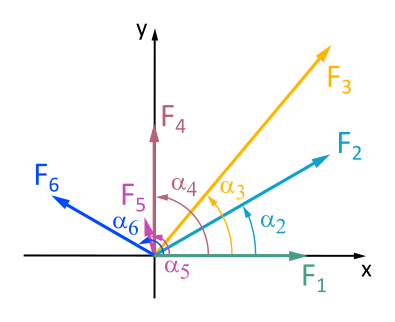
Central Force Systems
First Basic Task: Reduction to a Single Force

Graphically and analytically determine the magnitude and direction of the resultant force from forces F1 to F6.

Graphically and analytically determine the magnitude and direction of the resultant force from forces F1 to F5.

Graphically and analytically determine the magnitude and direction of the resultant force from forces F1 to F6.

Picture this: you've got two laundry lines, let's call them Line 1 and Line 2, that you need to attach to a wall. Imagine you're looking down at the setup from above. Something like this:
We know that the force acting on Line 1, which we'll call F1, is 100 Newtons (N).
Determine the force F2 acting on Line 2 in such a way that the combined force, or resultant force, is perpendicular to the wall.

The traction rope of a conveyor system runs at an angle of \(\gamma = 40°\) to the vertical from the pulley. Due to the mass of the conveyor basket, a rope force F1 = 50 kN results.
- What is the magnitude of the resultant of the two rope forces that act as bearing loads in pulley bearings A?
- At what direction angle \(\alpha_R\) (measured from the positive x-axis) does the resultant act?

Four people are pulling a cart with ropes that are hooked into the towing eye of the drawbar according to the sketch.
Given:
F1=400 N, F2=350 N, F3=300 N, F4=500 N
- Determine the magnitude of the resultant force R.
- Determine the direction angle \(\alpha_R\) of the resultant force relative to the horizontal line through the drawbar.
Second Basic Task: Equilibrium

Determine graphically and analytically whether the depicted system of forces is in equilibrium.
Third Basic Task: Decomposition of a Force
A force F = 25 N is to be decomposed into two components F1 and F2 which are perpendicular to each other. The lines of action of F and F1 are to form an angle \(\alpha = 35°\).
Determine the magnitudes of F1 and F2 graphically and analytically.

A mass with the weight force FG is hanging on two ropes.
What are the components of the force FG = 10 kN in the direction of ropes 1 and 2?

A sphere is situated, as shown, in a recess.
What are the components of the weight force G = 40 kN in the direction of the walls?
Note:
Only forces normal (i.e., perpendicular) to the wall can be transmitted.